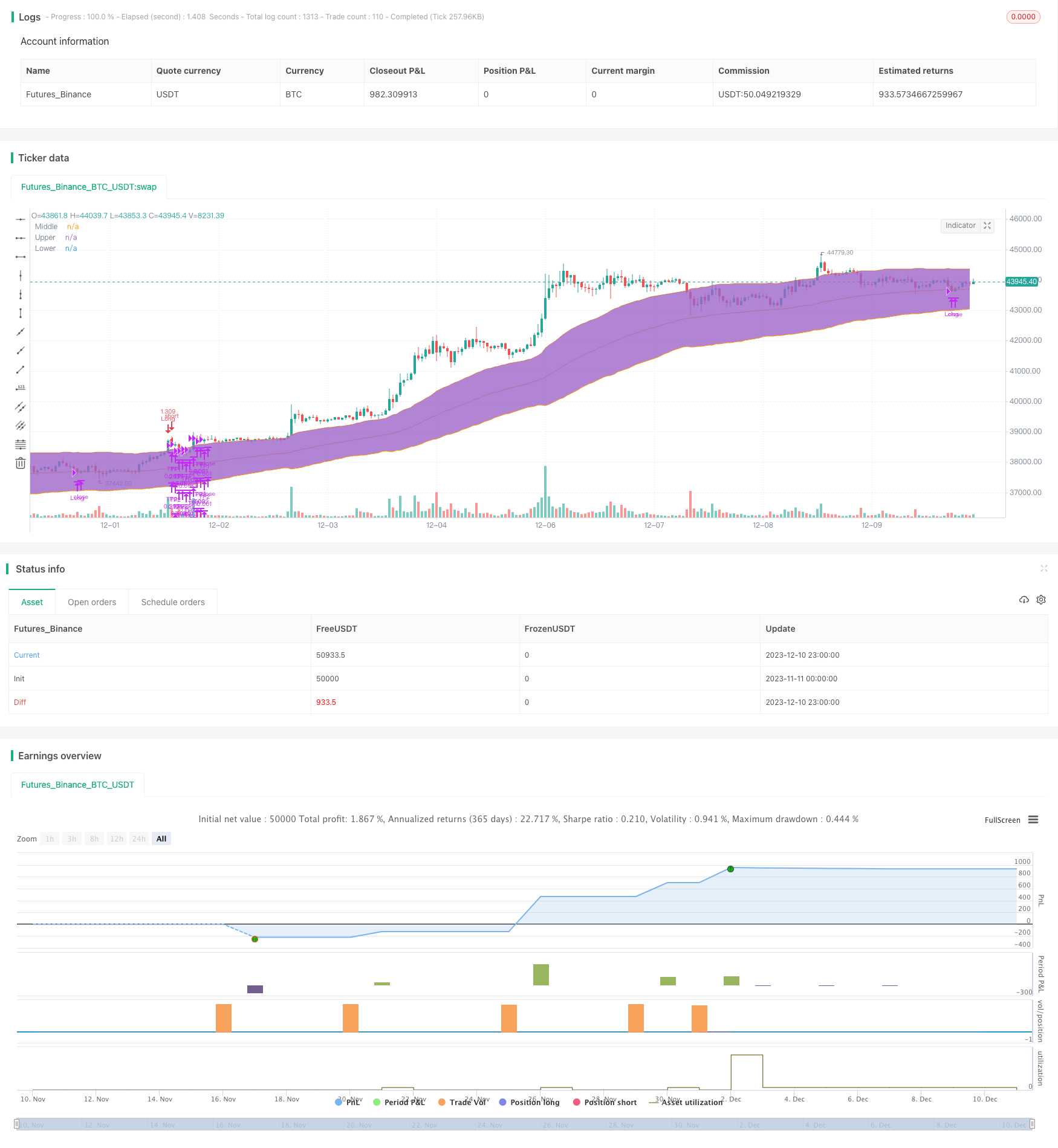
概述
该策略通过计算通道和动量指标,识别趋势形态,实现趋势追踪交易。具体来说,它结合了动量指标和均衡通道指标,利用两者配合使用,在介入 long 期趋势的同时,利用均衡通道来锁定多头获利区域。
策略原理
该策略主要使用以下两个指标进行判断:
动量指标(DMI):判断市场多空趋势,指标大于设置阈值时产生交易信号。
均衡通道(Keltner Channel):判断趋势区域,价格突破上轨时为买入时机,价格跌破中轨时为平仓信号。
具体交易逻辑为:当+DI动量指标大于设置阈值(默认32)时,判断为多头趋势形成,此时如价格突破均衡通道上轨,产生买入信号;之后利用均衡通道中轨作为止损线,跟踪止损,实现获利保护。
该策略综合运用两个指标的优势,利用动量指标判断趋势方向,利用均衡通道判断入场时机和止损区域。双重指标组合,使策略能够在发现趋势早期高效入场,同时利用通道指标锁定盈利和止损。
优势分析
策略利用动量指标判断市场趋势的早期,比简单移动平均线等滞后指标更加高效。
运用均衡通道判断具体交易区间,能够有效锁定获利区域。
指标参数和交易规则严谨合理,回测数据表现良好,实盘验证效果。
策略较为简单清晰,容易理解实现,适合量化交易初学者学习。
策略风险可控,采用中轨均线动态止损,有效控制单笔损失。
风险分析
策略仅适用于趋势行情,不适用于盘整波动市场,如遇QtCore通道增大,中轨止损过于宽松,无法控制损失。
DMI指标存在一定滞后,无法确定趋势确认,可能较早介入趋势带来损失。
固定百分比止损方式存在风险,大幅震荡后无法重新介入趋势,错过后续行情。
回测数据充足,但实盘仍需长时间运行验证参数稳定性。
优化方向
可以测试不同止损方式,如ATR止损、移动止损等方式替换固定百分比止损。
可以加入次级确认指标,如成交量放大,确保趋势确认后入场。
可以测试不同参数组合优化,寻找最佳参数组合。
可以通过步进优化和游动回测验证参数稳健性。
总结
本策略运用双重指标判断,实现了对趋势行情的高效捕捉。策略较为简单直观,逻辑清晰,回测表现较好,可作为量化交易的入门策略之一。但仍需充分验证实盘数据和优化参数,降低实盘跑输风险,将是未来的重点工作。
/*backtest
start: 2023-11-11 00:00:00
end: 2023-12-11 00:00:00
period: 1h
basePeriod: 15m
exchanges: [{"eid":"Futures_Binance","currency":"BTC_USDT"}]
*/
//Original Idea by: @Wunderbit
//@version=4
strategy("Keltner Channel [LINKUSDT] 1H", overlay=true, initial_capital=3000,pyramiding = 0, currency="USD", default_qty_type=strategy.percent_of_equity, default_qty_value=100, commission_type=strategy.commission.percent,commission_value=0.1)
/// TREND
trend_cond = input(true, title="Enable Ribbon Filter")
ribbon_period = input(30, "Ribbon Period", step=1)
leadLine1 = ema(close, ribbon_period)
leadLine2 = sma(close, ribbon_period)
// p3 = plot(leadLine1, color= #53b987, title="EMA", transp = 50, linewidth = 1)
// p4 = plot(leadLine2, color= #eb4d5c, title="SMA", transp = 50, linewidth = 1)
// fill(p3, p4, transp = 60, color = leadLine1 > leadLine2 ? #53b987 : #eb4d5c)
//Upward Trend
UT=leadLine2 < leadLine1
DT=leadLine2 > leadLine1
///////////////////////////////////////INDICATORS
// KELTNER //
source = close
useTrueRange = input(true)
length = input(80, "KELTNER Period", step=1, minval=1)
mult = input(3.0,"KELTNER Multiple", step=0.1)
// Calculate Keltner Channel
ma = ema(source, length)
range = useTrueRange ? tr : high - low
rangema = ema(range, length)
upper = ma + rangema * mult
lower = ma - rangema * mult
plot(ma, title="Middle", color=color.orange)
p1=plot(upper, title="Upper", color=color.orange)
p2=plot(lower, title="Lower", color=color.orange)
fill(p1,p2)
// DMI INDICATOR //
lensig = input(14, title="ADX Smoothing", minval=1, maxval=50)
len = input(14, minval=1, title="DI Length")
up = change(high)
down = -change(low)
plusDM = na(up) ? na : (up > down and up > 0 ? up : 0)
minusDM = na(down) ? na : (down > up and down > 0 ? down : 0)
trur = rma(tr, len)
plus = fixnan(100 * rma(plusDM, len) / trur)
minus = fixnan(100 * rma(minusDM, len) / trur)
sum = plus + minus
adx = 100 * rma(abs(plus - minus) / (sum == 0 ? 1 : sum), lensig)
trig_level=input(title="+DI Trigger Level", defval=32, minval=1,step=1)
//trig_level_adx=input(title="ADX Trigger Level", defval=30, minval=1,step=1)
//plot(adx, color=#FF006E, title="ADX")
//plot(plus, color=#0094FF, title="+DI")
//plot(minus, color=#FF6A00, title="-DI")
// plot(trig_level, color=color.white, title="Key Level")
///////////////////////////////////////////////////////////
////////////////////////////////////////////////////Component Code Start
testStartYear = input(2019, "Backtest Start Year")
testStartMonth = input(1, "Backtest Start Month")
testStartDay = input(1, "Backtest Start Day")
testPeriodStart = timestamp(testStartYear,testStartMonth,testStartDay,0,0)
testStopYear = input(2030, "Backtest Stop Year")
testStopMonth = input(12, "Backtest Stop Month")
testStopDay = input(31, "Backtest Stop Day")
testPeriodStop = timestamp(testStopYear,testStopMonth,testStopDay,0,0)
testPeriod() =>
time >= testPeriodStart and time <= testPeriodStop ? true : false
///// Component Code Stop //////////////////////////////////////////
//////////////// STRATEGY EXECUTION //////////////////////////
// STRATEGY CONDITION
// LONG
long = ((open > lower and open < upper) and close > upper) and plus > minus and plus > trig_level and volume[0] > volume[1]
entry_long = trend_cond ? long and UT : long
exit_long = (close < ma) //or low < SL_long
//LONG SET UP
// Take Profit / Stop Loss
entry_price_long=valuewhen(entry_long,close,0)
//SL_long = entry_price_long * (1 - long_sl_inp)
long_tp1_inp = input(8, title='Long Take Profit 1 Target %', step=0.1)/100
long_tp1_qty = input(20, title="Long Take Profit 1 Qty %", step=1)
long_tp2_inp = input(16, title='Long Take Profit 2 Target %', step=0.1)/100
long_tp2_qty = input(30, title="Long Take Profit 2 Qty %", step=1)
long_take_level_1 = strategy.position_avg_price * (1 + long_tp1_inp)
long_take_level_2 = strategy.position_avg_price * (1 + long_tp2_inp)
//long_sl_inp = input(4, title='Long Stop Loss %', step=0.1)/100
//long_stop_level = strategy.position_avg_price * (1 - long_sl_inp)
// STRATEGY EXECUTION
if testPeriod()
// LONG
strategy.entry(id="Long", long=true, when=entry_long, comment = "INSERT ENTRY LONG COMMAND")
strategy.exit("TP1","Long", qty_percent=long_tp1_qty, limit=long_take_level_1) // PLACE TAKE PROFIT IN WBT BOT SETTINGS
strategy.exit("TP2","Long", qty_percent=long_tp2_qty, limit=long_take_level_2) // PLACE TAKE PROFIT IN WBT BOT SETTINGS
strategy.close(id="Long", when=exit_long, comment= "INSERT EXIT LONG COMMAND")
//PLOT FIXED SLTP LINE
// LONG POSITION
plot(strategy.position_size > 0 ? long_take_level_1 : na, style=plot.style_linebr, color=color.green, linewidth=1, title="1st Long Take Profit")
plot(strategy.position_size > 0 ? long_take_level_2 : na, style=plot.style_linebr, color=color.green, linewidth=1, title="2nd Long Take Profit")
//plot(strategy.position_size > 0 ? long_stop_level : na, style=plot.style_linebr, color=color.red, linewidth=1, title="Long Stop Loss")